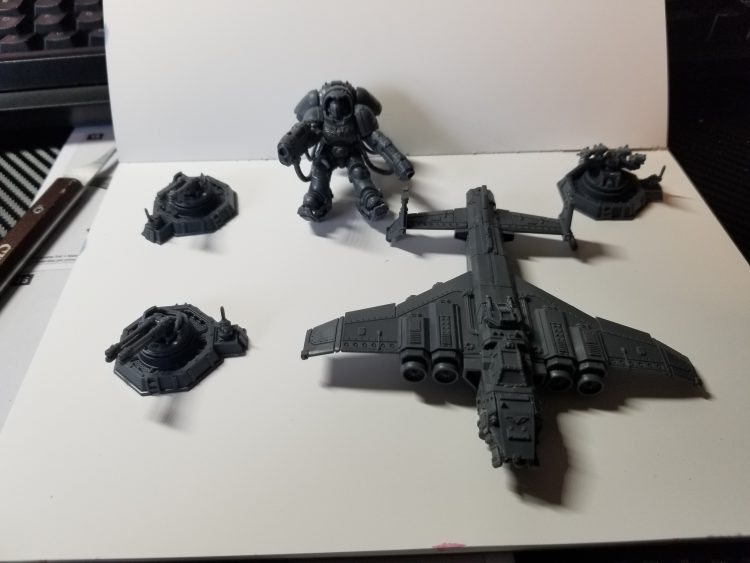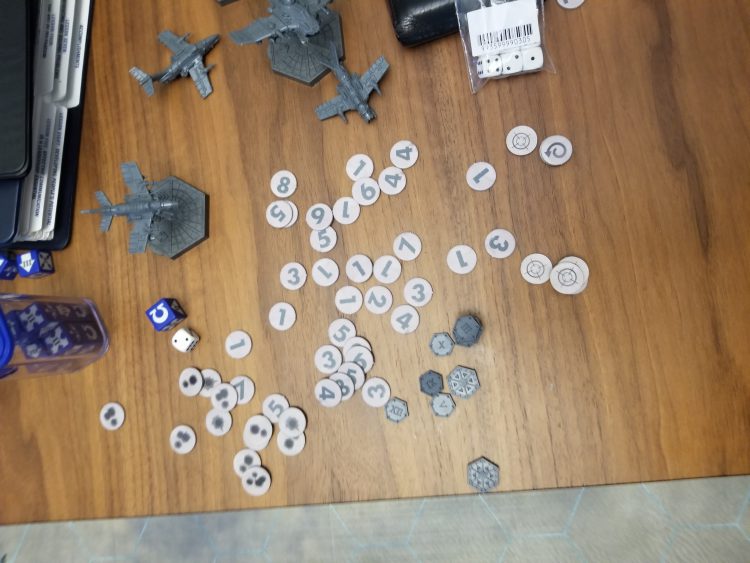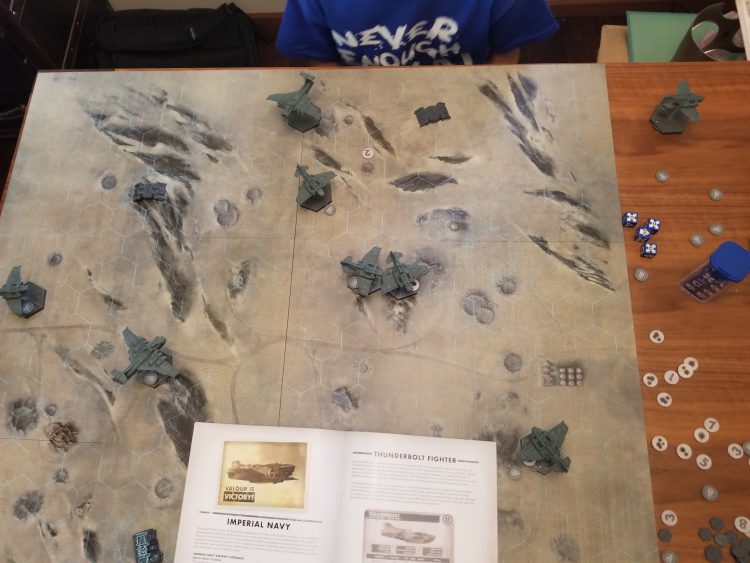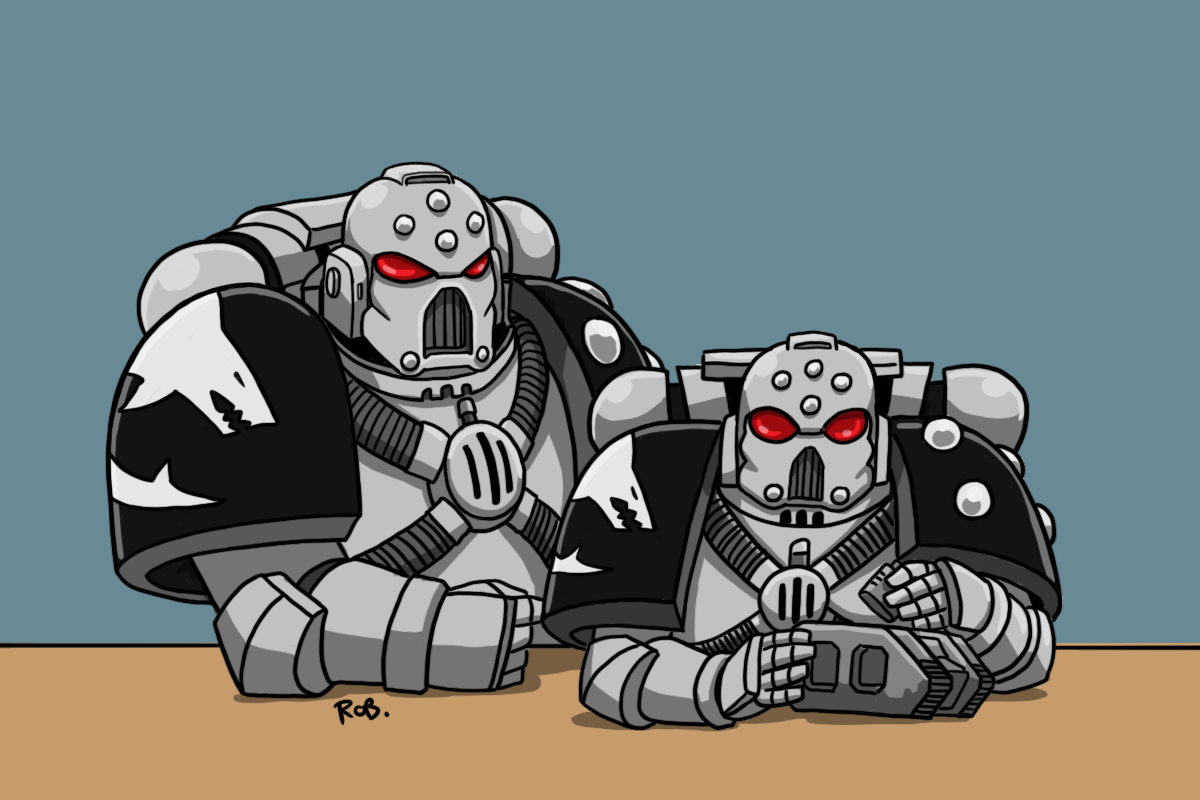Hello, Immanentized back with another entry in the Unclehammer canon!
Games Workshop released Aeronautica Imperialis on September 7th, and I’ve gone through the trouble of buying every available kit on release and reviewing it all for you wonderful readers here.
As always, I was assisted by my nephew, and got some feedback from some other local players who ranged from tiny-plane-curious, to tiny-plane deniers. To jump ahead, click on one of the links in the Table of Contents below.
This review is based on one demo game at NOVA with the GW community team, and three full-on games of AI played with; one (1) child, two (2) immature adults, and 1 (one) elderly person who is not at all into Games Workshop products. A total of about 2.5 hours of play time, and about 3 hours of reading and digesting the rules were involved here, but I definitely plan on putting much more thought and effort into this game as it develops.
Table of Contents
I. The Models
Herein I will gush about the quality, ease of assembly, and detail of the planes involved in this game. For this part of the review, I will be referencing the models contained in the Wings of Vengeance Box, Imperial Thunderbolts, Imperial Marauder, Imperial Marauder Destroyer, and the Ground Assets add-on option. The level of detail on these things is utterly insane, with rivets, fanblades, individual gun barrels and ammo feeds rendered clearly, with tons of opportunities for the truly deranged among you to highlight every last rivet on the Imperial planes’ canopies. Each reinforcement box retails for $40 US, which nets you 4 Imperial/6 Ork fighters, and 2 Imperial/4 Ork bombers. Similarly, the Ground Assets box, which contains 12 emplacements (6 for each faction), 4 objective markers, 2 drop zone markers, and 10 counters comes in at $40, but I wouldn’t necessarily recommend this as an initial purchase as it’s only useful and usable if you intend on buying expansions. More on this in section II.
For reference, the scale of the planes is pretty much identical to Adeptus Titanicus, and there definitely is consistent sizing between assets and the planes themselves. The models are small enough to fit into/on top of the 2 inch hexes that make up the game board, while enabling clear visual reference to differentiate between armament, loadout, and role. Below, I’ve compared the size of a Marauder Destroyer, the biggest currently available plane; to a Primaris Inceptor, with 3 ground assets for reference. These things are hefty, and besides being used for AI itself would make great (if pricey) terrain for an AT game

In my opinion, while the Imperial planes are beautiful 1:1 recreations of their bigger resin counterparts, the Ork jets are the winners in the customization and options category here. Each sprue of Dakkajets contains the parts to make 3 planes. Each plane comprises a unique cockpit/body, nosecone, multiple exhaust vents, and tail, giving the player a lot of potential to truly make their squadron/air Waaagh/targets stand out on the table top. Similarly, the Fighta-bommerz kit comes with 2 unique designs for the front intake, rear exhaust, horizontal stabilizer, and upper turret, within a kit of 4 planes. While not as dynamic as the Dakkajets, this enables a good deal of customization on your more useful and effective machines. (Again, more on this later)
II. Accessories

The Wings of Vengeance box comes with literally all you need to start playing AI from the get go, including cardboard markers for various game states, some basic dice, and reference sheets for both maneuvers and core game concepts. While these sheets and tokens aren’t the most durable products, knowing that there is a vibrant and extensive secondary offerings market for specialist games, I’m not going to focus on calling these sellers out, or identifying alternatives. Also included in the Wings of Vengeance kit are quick-start rules. These contain a little bit of context and clarification on key concepts, specific movement, attacking, and maneuvering rules, as well as limited scenarios and expansion of rules.
This is where I had a problem with this release.
While I understand that the box set is explicitly there to jump start interest and purchasing, it was severely lacking in explaining and detailing core concepts of the game, and didn’t provide the full rules for the bomber units included in the box. Here’s where the Rynn’s World Campaign book, and the Aces/Aircraft and Crew cards, come in. You will need these additional expansions to play AI. You will also need the Rynn’s World book to use bombers, and play with additional scenarios and situations. Also included in Rynn’s World is additional information on how to tabulate victory points, modify outcomes, and clearer detail on how to use speed, altitude, and fire arcs. This book is a $40 add-on, as are the Rynn’s World Areas of Engagement. If you want to get into this game, I recommend both purchases.
The Aces, Aircraft, and Crew cards are similarly essential, and make the game much more engaging and fun to play. Aces and Aircraft operates like your Codex, providing unit info, wargear, special character information, and special rules for each aircraft; additionally, they give you super useful quick reference rules for each individual item of aircraft loadout, and provide unit cards, points costs for your ground assets, which are purchasable and usable units in certain scenarios.
III. Set Up and Rulesets
I will reference the Rynn’s World Air War campaign book as the primary rulebook here. The Wings of Vengeance packaged quick start rules are usable, but not detailed, and contain some oddly worded sections that don’t clearly state the use case or intent of the rules relating to firing, maneuvering, and completely leave out swathes of advanced rules and situational weaponry.
The game is set up with an average of 12 turns, divided into 6 distinct phases, starting with the “tailing fire” free-shot phase, and ending with end of round consolidation. In between are the maneuver selection, roll for initiative, movement, firing, and resolution phases. If you’ve ever played Fantasy Flight Games’ X-wing you’ll have some strong feelings of familiarity with this. Aircraft must select pre-designated “ace maneuvers” that tie to their aircraft’s handling, and their selected speed for each turn. There are rules for stalls and spins, but we didn’t encounter a need or a use for those during our review games. The maneuver selections are pretty comprehensive and allow for full integration and tactical positioning of your aircraft within the Area of Engagement. Additionally, by playing with your aircrafts’ speed and altitude settings, the player is fully empowered to represent a 3d engagement space, with all of the additional tactical options that represents. A full game is said to be around 100-200 points, and ends up with a pretty packed board. For our tests we used the boxed set (around 100 points per side), and matched play of 85v85 using Imperial planes. This game is a lot of fun on the bigger boards included in the Rynn’s World expansions.

IV. Gameplay
In terms of initial balance, each faction is imbued with a definite style and method for using and succeeding with their planes (oh hey, I guess this is a themed tabletop wargame after all). The Orks are best in close-quarters knife fight range, and have higher speed and lower handling to represent their brute force approach to fighting. They almost entirely lack long range (8-10 hexes) weaponry and have lower durability on their currently available aircraft – 2/3 structure points vs the Imperium’s 3/5. However, their aircraft and weaponry are costed to make this more competitive, and you will end up with more planes than your opponent in early game, though don’t get too attached to any individual one! The Imperials exist in that weird bubble of all-around competency, with minimal exceptionalism. Most of their planes do best at medium range, and their weaponry dishes out adequate damage at achievable ranges. Lascannons will mess up an Ork player during your initial phase so there is a bit of risk/reward to rushing straight at your opponent’s squadron in an early turn; additionally, having your Marauders go low and slow enables that sweet, sweet dorsal turret to shoot a full 360 and add to your formation’s defense. The addition of missiles, chaff, etc can significantly unbalance a game, but I think there are other issues involved that I’ll go into below.
With the boxed rules and aircraft in Wings of Vengeance, an Ork player can and will get wiped out by turn 2, if the Imperial player is able to engage their lascannons at long range and at similar altitudes. It is difficult, by design, for aircraft to hit one another in passing, or flank fire, which makes tailing (slotting in behind an enemy aircraft’s rear 60′ arc) critical for the free shot prior to the normal round actions. Missiles, bombs, targeting, armor, and decoys are available to both sides in the quick rules, which makes the game last a little longer, but the campaign book and supplements allow for much needed nuance and increased precision to the game. I feel like, at least initially, we’re going to see a LOT of Imperial vs Imperial games, just due to the forgiving nature of their playstyle, and the increased utility of most of their weapons. Close quarters in this game can and does happen frequently, but if you play against opponents who use their speed and aggressively pursue squadron formation tactics, it’s going to be a game of mid-range engagement.
Frankly, I’m looking forward to seeing future releases, maybe a greater focus on strategic engagement that isn’t multiple variations on dogfights. I feel as though escort missions or ground support operations would add a ton of depth to this game, and based on the rules and FAQ present in the Rynn’s World campaign book, I fully expect a whole mess of new aircraft, ground assets, and possible mobile AA to be added into the game in the near term.
V. Additional Thoughts
I am really excited for the future of this product line from Games Workshop. I went into my purchase full-on, having missed out on both my local X-wing community, and the previous release of Aeronautica Imperialis. Based on my initial experience, this is a really fast game, like stupidly fast, especially once players get a handle on tailing rules, and their maneuvering options. For two of my four practice games, I was defeated (as Orks) by turn 2. For the other two, matched Imperial forces were able to make it to turn 8, with our planes full of holes and half our ground targets destroyed.
If you know you’re going to enjoy this fast-paced, high concept game, I would encourage you to skip the box set and buy your faction of choice, with the campaign book/cards from an online discount retailer, or to give GW the full price if you’re into that (I tend to do that with first wave releases). If you’re more curious than sure, the Wings of Vengeance set is perfectly serviceable for introduction games and getting a handle of the basic mechanics (as well as 50% off the value of the included aircraft and tokens).
I really want to see this game grow and succeed, if only because it’s such a refreshing break from GW’s other time-intensive offerings. I love Kill Team, 40k, and I’m just dipping my toe into Adepticus Titanicus, but Aeronautica Imperialis has potential as a great competitive offering that I can see finding comfortable and popular slots at future tournaments and open days.
Final Thoughts
If your local FLGS, or GW company store have demos set up, I strongly encourage you to attend and give it a shot. If you know any X-wing fans, I encourage you to also bring them along, as I think there are some things AI does better in movement and combat resolution.
Overall, my rating would break down as follows:
Value of Starter box: 7/10 – Models are at a great discount, but you’ll need to spend 100% of box cost again just buying full rules and cards to manage assets, etc
Quality of Models: 10/10 – Some of the greatest mechanical kits GW has put out. End of story.
Clarity and quality of rules: 7/10. Definitely needs some work, but a great initial offering, especially with such limited factions.
Ease of Play: 8/10. The Becca Scott video is also a great intro.
Time to Play: About 20-30 minutes for a dogfight scenario. 40+ for conservative playing
Overall: I’d rate the initial offering as an 8/10. GW is laying the foundation for expansion for this line over the near term, and there’s things in the campaign book that hint at major game play and tactical expansions to come down the pipe. This is new territory for Games Workshop and the Specialist Games team, and first impressions from me are positive.


